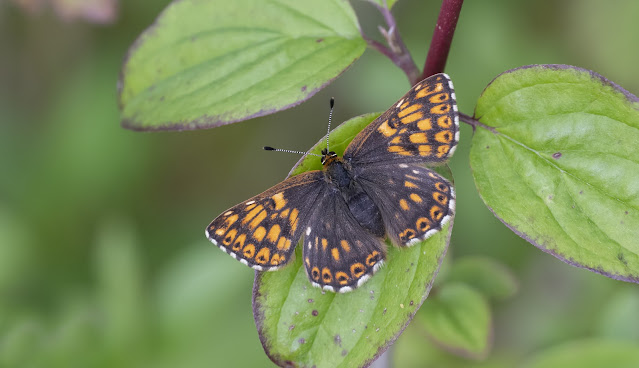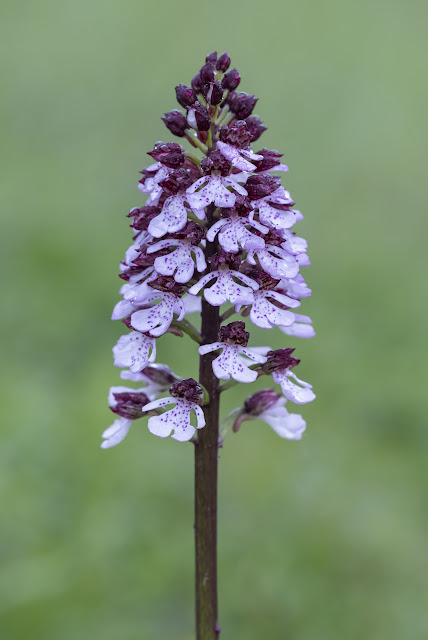One of my favourite places to visit, is deep in the Kent countryside in May. Although I have Duke of Burgundy nearer in West Sussex, I love seeing them in woodland habitat, and there is always the chance of some interesting and rare moths, deep in the Kent woodlands. In fact, the main target these days on my Kent visits, is the chance of encountering my favourite little micro moth, the Anania funebris, also known as the White-spotted Sable. This moth is now probably extinct in Sussex, with the very last sightings in the county being in 2018, when Mike Mullis and myself both saw singles at a private wood that we survey.
I love visiting this area of Kent so much that this year I have done it twice. The first visit was with David. It was also my birthday, which was also the first day of me officially being a pensioner!!
The weather was actually perfect, with our arrival being in overcast conditions, but as we got to the area with the Duke of Burgundy, the sun started to show through, which meant the butterflies started to appear. The first of which was a male Duke of Burgundy that I spotted in less than a minute of us arriving on site.
Male Duke of Burgundy.
Moments later David spotted a female that was basking with her wings wide open. We both managed to get several images of her as she fluttered about. It was so lovely getting these opportunities so early in the day.
Female Duke of Burgundy.
As the day was now warming up quickly, the butterflies became more active, so we started to wander about. We did come across several lovely Fly and Lady Orchids.
Fly Orchid.
I also spotted the first Anania funebris. We both followed the tiny moth for a few minutes, and tried to photograph it as it sat briefly several times, although we never really stood a chance. This species is extremely difficult as it mostly hides under leaves and seems to sense any movement, so it is constantly flying off again. It very quickly vanished, and despite searching in the area, we never did see that one again!!
We then headed away from the main site, to another area up the hill. Here David spotted another micro moth that I don't think I've seen before. The Ancylis unculana is rare in Sussex, only found in a few sites in West Sussex, so it was a really nice find. Unlike the Anania funebris, it also just sat there for us to photograph it.
Ancylis unculana.
Not long after this, I spotted another Anania funebris. Once again, the moth gave us the run around. It was in terrific condition, and as it was my main target for the day, I was really keen not to lose this one. Once again it kept hiding under leaves and flying off whenever we got within a few feet of it. It was beginning to look like a lost cause. Just before we gave up though, it sat for a longer time under a leaf, and I very carefully turned the leaf over, expecting it to fly as soon as there was some movement, but amazingly it actually stayed on the leaf. Although I was holding the leaf with one hand, we both managed to get a few shots of this beautiful rare moth.
Anania funebris (White-spotted Sable).
Following this success, we decided to head off to visit a site for the Man Orchids. However, before we left we did enjoy watching more Duke of Burgundy and Green Hairstreak and also admiring the Lady Orchids.
Lady Orchid.
At the downland site for Man Orchids we came across a very fresh Holly Blue. Although these blues are common, I rarely get them in a position to photograph them. As it was now very warm, the butterfly wasn't going to open its wings, but it was still nice to see it close up.
Holly Blue.
The Man Orchids were unfortunately, not fully in flower, so we didn't spend too much time with them. The long drive home though, was made easier knowing we had had an extremely good day!!
I actually enjoyed the trip so much, that I decided to do it all again 9 days later. This time I took Lisa, as she was keen to look for some of the rare orchids that are found in Kent. Once again we started at the Duke of Burgundy site. It was actually pretty warm by the time we arrived, and already many of the Duke's were sheltering from the heat. Incredible really, as the previous day had been a total washout!! Several Duke of Burgundy were seen though, but my main target was once again, the Anania funebris. By now their numbers had increased and we saw well into double figures, as against just the 2 the previous week. At times we were trying to follow 2 of them at the same time, and once again they kept giving us the slip as they vanished amongst the foliage. At last one was sitting right in front of me. I called Lisa over, but she was actually photographing one nectaring on some Speedwell. The moth however, was actually still there when she had finished with her one, so she also managed a few photos of my one.

Anania funebris. (White-spotted Sable).
When it did eventually fly off it landed on a plant in the shade and seemed to go to sleep allowing us both to lay on the ground and get some more shots, this time with a less messy background, although our trousers were pretty messy when we had finished with the moth!!
Anania funebris (White-spotted Sable).
Following this we just enjoyed meandering around watching the butterflies and orchids, as well as other wonderful insects.
Fly Orchid.
Chequered Weevil.
Hazel-leaf Roller (Apoderus coryli).
As we walked past a Lady Orchid, for some reason my eye was attracted to one of the flowers. On closer inspection, it was a Crab Spider that was sitting there hoping that it could catch some lunch. After I had photographed it, a micro moth landed right next to it, but the spider actually didn't go for it. Maybe it wanted a larger lunch!!
Crab Spider on Lady Orchid.
Following this we headed off to some of the Orchid sites in the area. Unfortunately, just as we arrived at the Monkey Orchid site, the heavens opened. Very similar to the day before, when I had to abandon my Naturetrek tour early. The road where we were parked was actually flooded in no time by the water. But we did hang on as the forecast was for the rain to be short lived. It was still about 45 minutes though before it eased enough for us to get out of the car. The orchids were now very wet, but in a way it was nice to get different photos from the normal. Most years I normally miss the Monkey Orchids in their prime, as when I go for the Duke early in their season, it is too early, and the next time I normally go to Kent for the Heath Fritillaries it is often too late. This time though, there were some Monkey Orchids at their finest. There didn't seem to be as many though this year, so hopefully more are still to come.
Monkey Orchid. (complete with rain drops).
Also on site were several Fly and Lady Orchids, with some Butterfly Orchids starting to open.
A very fine Lady Orchid.
Following a lovely search along the hillside we headed to see if there were any Late Spider Orchids out yet. It was a little bit early, but a small number had just started to open.
Late Spider Orchid.
The Man Orchids that David and I were too early for last week, were now out at their best. By now the sun had come back out again. The Man Orchids are beautiful, and one of my favourite orchids. In Sussex we only have one regular small colony, but in Kent there are several colonies, and some are very large. The site we looked at today is not that large, but it does have a few really nice plants.
Two plants were displaying well together, so I photographed them from both sides, which gave a different aspect to them.
Man Orchid.
The Two Man Orchids.
Both of my Kent days were wonderful. The first one to celebrate making it to my pension, and the 2nd showing Lisa so many fabulous species. I will remember both days for a long time. I also loved the challenge of trying to improve on my photos of the Anania funebris. I'm not sure if they are better than my previous photos, but I am pleased to have several more shots of them now. I know both David and Lisa are pleased to have now got some photos too of this frustrating little beauty!! It is a moth that is also found in Scotland, and as I'm heading that way soon, there may be more opportunities for them there!!





























